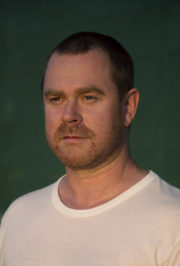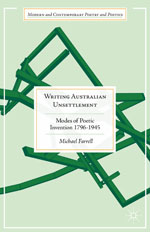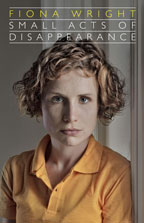 Hook and Eye
Hook and Eye
By Judith Beveridge
Braziller, Ed Paul Kane
ISBN 978-0-8076-0000-9
Reviewed by MICHELE SEMINARA
Judith Beveridge’s Hook and Eye is a collection of previously published poems selected to showcase the highly regarded Australian poet’s work to an American readership. The poems are for the most part imaginatively — rather than autobiographically — conceived, lyrical while still remaining largely outward looking, and full of the sensual imagery and sound-play for which Beveridge’s work is prized. Yet what is most striking about the book, comprised of work written over a twenty-five year span, are the enduring and distinctive spiritual concerns of the poet, and how these inform her praxis.
As Maria Takolander points out in a recent review[i], the book’s first poem, ‘Girl Swinging’, seems deliberately placed to give the reader insight into (perhaps even guidance for entering) the poet’s creative practise.
I often think about
the long process that loves
the sound we make.
It swings us until
we’ve got it by heart;
the music we are.
(‘Girl Swinging’)
The process of creation rather than the creation itself is paramount, a process which (like Beveridge) ‘loves’ playing with ‘the sound we make’ and which ‘swings us’ until we come to understand, at a heart level, ‘the music we are’. There is a profound desire for personal transformation: the speaker, longing ‘to be a symphony / levitated by grace-notes’, turns quietly within, ‘listening to myself’ until ‘that feeling comes / of being lifted into the air’. Takolander has convincingly argued that lyric poetry is fundamentally a poetry of embodiment and senses a paradox here in the way the remembered sensations of the girl’s body ‘swinging’ generate the adult speaker’s spiritual disembodiment. Yet it is not merely sensory experience which leads to this state – it is the poet’s attentive focus upon the girl’s sensory experience which foreground a form of mindfulness and lead the narrator of ‘Girl Swinging’ to her own kind of lyric elevation. Beveridge’s poetry could perhaps be called a poetry of conscious embodiment; here, physicality acts as tool for deepening the narrator’s awareness until she rises into a space of ‘…clear singing / …above / the common rattle / of chains’.
The life of the future Buddha Siddhartha Gautama, and also that of his antagonistic cousin Devadatta, are the subject of Beveridge’s previously published poetic sequences ‘Between the Palace and the Bodhi Tree’ and Devadatta’s Poems , extracts from which appear in this collection. In one such poem, ‘The Kite’, narrated by Siddhartha as he progresses towards enlightenment, the image of a boy expertly controlling a kite in the wind suggests how he might gain similar control of his own errant mind – how he might learn to make it ‘sing’.
Today I watched a boy fly his kite.
It didn’t crackle in the wind – but
gave out a barely perceptible hum.
At a certain height, I’d swear I heard
it sing. He could make it climb in
any wind; could crank those angles up
make it veer with the precision
of an insect targeting a string…
(‘The Kite’)
The word ‘hum’ here carries dual meanings. It evokes the same sense of musicality, of ‘singing’ as an analogy for poesis as in ‘Girl Swinging’, yet it also carries a spiritual meaning. ‘Hum’ is suggestive of ‘Aum’, an English translation of the Sanskrit symbol ॐ, which, tellingly, has no exact linguistic meaning but expresses the non-divisible unity of of the body, speech and mind of an enlightened being. It is mantra, or enlightened sound, believed – in the Buddhist tradition – to vibrate at frequencies capable of setting up harmonic resonances within the mind/body of the practitioner, frequencies capable of unblocking internal energies obstructing an experience of our true nature – ‘the music we are’. In ‘The Kite’, Siddhartha has an epiphany when he realises it is not through the practise of asceticism, or withdrawal from the world of the senses, that he may learn to make his mind ‘hum’ like a kite, but by directly and consciously engaging with the world. Like the narrator of ‘Girl Swinging’, Siddhartha’s mindful focus upon sense perceptions hones his awareness and helps his mind ‘fly’.
The dual meaning of the word ‘hum’ is revealing and offers a way of understanding Beveridge’s poesis as a type of sacred ‘singing ’. She states: ‘Sometimes I want the effects of my poetry to be subliminal, as if the poems were tuning forks vibrating at a pitch just out of ear-shot, but which are secretly changing the structure of thought and feeling.’ [ii]
As the practise of mantra and chanting in many spiritual traditions attests, sound is a powerful tool for mental transformation; perhaps, for Beveridge, poetry, like mantra, is a form of spiritual practise.
The poem ‘In the Forest’ further explores the theme of the transformative power of mindful observation:
… But sometimes,
watching a butterfly emerge, I sense
my own eyelids flutter in the strange
puparium of a dream. O, I don’t know
if I’ll ever wake, changed, transformed,
able to lift on viridescent wings.
But as I watch, I feel my mind enter
a vast space in which everything
connects; and a grasshopper on a blade
of grass listens intently with its knees.
(‘In the Forest’)
This poem, narrated – like ‘The Kite’ – by Siddhartha, is reminiscent of the famous story by Chinese philosopher Zhuang Zhou, who, upon waking from a dream of being a butterfly, ‘did not know whether he was Zhou who had dreamed of being a butterfly, or a butterfly dreaming that he was Zhou’[iii]. In ‘In the Forest’ we once again encounter a distrust of the conceptual – ‘I don’t know’ the speaker tells us; a focus on the power of observation when co-joined with pure sense perception – ‘I watch’, ‘I sense’; and an emphasis on how one must ‘feel’ one’s way into the ‘vast space in which everything / connects’. To ‘feel’ is to experience emotionally as well as physically, suggesting that perhaps the two must unite if Siddhartha is to enter the ‘vast space’ of enlightenment. The synaesthetic image of the grasshopper listening ‘intently with its knees’ symbolises the interconnected nature of this vast inner space. However, the image is not simply expressive, but a scientific fact: grasshoppers do indeed listen with their knees, implying that for Siddhartha the mental state ‘in which everything/ connects’ is less a fantasy than an achievable reality.
The spiritual world view which informs Beveridge’s poetry is evident not only in her choice of subject matter and the meticulous detail of her imagery, but also in the way she uses an array of speakers to narrate her poems. In his Note On Judith Beveridge at the beginning of Hook and Eye, Paul Kane remarks that Beveridge has said she is ‘not at all interested in writing about herself’, observing that this ‘attitude of self-effacement…opens up the world of the poet rather than the poet herself’. It also opens up the concept of the ‘I’ in a way that many Eastern spiritual traditions do; by using imaginative characters (Prince Siddhartha, Devadatta, various fisherman) to ‘author’ the poems in the book, Beveridge explores and shifts around the ‘I’ in ways which suggest ‘I’ is not a set concept. Certainly, as a poet, she is more interested in inhabiting the ‘I’ of others, in examining what it is in the human psyche that unites us.
Of course, not all of Beveridge’s poems deal overtly with Buddhist subjects. ‘To the Islands’ is a poem which uses the spiritual metaphor of rowing to a far-off shore as the basis for both an auditory meditation and a manifesto on how the speaker plans to journey:
I will use the sound of wind and the splash
of the cormorant diving and the music
any boatman will hear in the running threads
as they sing about leaving for the Islands.
(‘To the Islands’)
The speaker of this poem eschews conceptual knowledge as a method for undertaking her journey, admitting, ‘Look – I don’t know // much about how to reach the Islands’, instead layering auditory image upon image, each becoming more subtle – as the mind that perceives such subtle sounds would need to be, and as the mind that reads them gradually becomes:
Meanwhile I’ll use the sound of sunlight
filling the sponges and a diver’s saturated
breathing in the lungs of an oarsman
rowing weightless cargo over the reefs.
The strength of imagist poems like ‘To the Islands’ is that they allow the reader to experience for themselves a process of mindful awareness. It is common in Beveridge’s poems for the syntax, like the mind in its ‘watching’, to meander, the lines cascading over the stanza breaks and the sentence structures never quite concluding . This sense of flux is expressed, unsurprisingly, to greatest effect in the watery poems of the book – the ones excerpted from ‘Driftgrounds –Three Fishermen’, where the images don’t so much build as flow, often in the progressive tense, giving the reader the experience of flowing along with the narrator.
The mouth of a little fish had just sipped away a star
from the river, a lyrebird was opening the day, volunteering
to be a bell. We were watching an egret prod at the nutrient
dark, its beak one tine of a fork catching what floats, just
as the sun began cracking the trees awake. The bird’s song
reached us, then it sharded into the river’s cold glass.
(‘River Music’)
In poem after poem of Hook and Eye we are similarly invited to ‘watch’, ‘hear’ and ‘feel’ experiences directly along with the poet via her sensual imagery, syntax and sound play. The effect on the quality of our own awareness is cumulative, subtle, yet palpable; we can feel our minds slowing, focusing and deepening.
In a guest post for The NSW Writers’ Centre on poetry and spirituality Beveridge wrote:
Throughout history, poetry has always been the most powerful and effective form for addressing and exploring deep spiritual questions. Partly this is because poetry is connected so intimately with the breath. Poets know that the breath can act as an interpreting spirit, something which will help move, uplift and carry lived experience into rhythms and tones which allow both writer and reader to feel as if they are in communion and intense dialogue with the world around them.
Poetry as an art form employs repeating structures of sound, image and rhythm, and this patterned approach enables both writer and reader to access knowledge in non-discursive ways. Patterns can lead to insights and revelations which may not be attained or reached through logical or rational methods alone. [iv]
Beveridge could be describing her own poetry here: it is she who is the master of ‘show don’t tell’, not merely imaginatively presenting a scene but subtly shifting her reader’s very perception. Like Grennan in the poem ‘Grennan Mending Nets’ the poet helps us to feel our own minds ‘drift’, to experience how good it is ‘to just let fish and weather turn [our] head; to sit and work / taking thread from warp to weft’. Reading Hook and Eye we find ourselves shaking our heads the way the eponymous Delancey does, ‘just working / it slowly – like a sieve at the water’s edge’ of Beveridge’s poems. Or perhaps if – like Beveridge in her writing – we have been especially attentive in our reading, we may find ourselves, like Devadatta in the final poem of the book, ‘At Rajkote, After the Rains Retreat’, emerging from our poetically induced meditation with an awareness so sharp we ‘could reckon / a hare’s smell down to a point, accurate as a compass’; have our thoughts come ‘as airily as insects skimming / over a pond’; or experience ‘a peace come over’ us which has ‘the equanimity / of snow’. If poetry is capable of inducing such sublime experiences, surely it is the poetry of Judith Beveridge.
Notes
[i] Takolander, Maria. ‘Review Short: Judith Beveridge’s Hook and Eye.’ Cordite, 16 June 2015. Web. 10 August 2015.
[ii] Takolander, Maria. ‘Review Short: Judith Beveridge’s Hook and Eye.’ Cordite, 16 June 2015. Web. 10 August 2015.
[iii] Mair, Victor H. Wandering on the Way: Early Taoist Tales and Parables of Chuang Tzu. New York: Bantam Books, 1994. Print.
[iv] Beveridge, Judith. ‘Making Space for the Inner Life: Judith Beveridge on Poetry & Spirituality.’ The NSW Writers’ Centre, 2013. Web. 5 August 2015.
MICHELE SEMINARA is a poet, editor, critic and yoga teacher from Sydney. Her writing has appeared in publications such as Bluepepper, Tincture Journal, Regime, Seizure, Plumwood Mountain and Social Alternatives. Her first collection, Engraft, was published by Island Press this year. Michele is also the managing editor of online creative arts journal Verity La.
 Stuart Barnes was born in Hobart, Tasmania, and educated at Monash University. Since 2013 he has lived in Central Queensland and been poetry editor for Tincture Journal. His manuscript The Staysails won the 2015 Arts Queensland Thomas Shapcott Poetry Prize, resulting in the publication of his first book, Glasshouses (UQP, August 2016). His website is
Stuart Barnes was born in Hobart, Tasmania, and educated at Monash University. Since 2013 he has lived in Central Queensland and been poetry editor for Tincture Journal. His manuscript The Staysails won the 2015 Arts Queensland Thomas Shapcott Poetry Prize, resulting in the publication of his first book, Glasshouses (UQP, August 2016). His website is  Hook and Eye
Hook and Eye Writing Australian Unsettlement: Modes of Poetic Invention 1796-1945
Writing Australian Unsettlement: Modes of Poetic Invention 1796-1945


